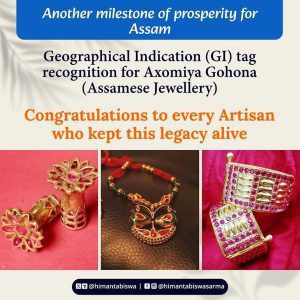Introduction: A Historic Achievement for Assam’s Traditional Jewelry
In a landmark recognition for Assam’s rich cultural heritage, Axomiya Gohona, the traditional jewelry of the region, has been awarded the Geographical Indication (GI) tag. This distinction places Assamese jewelry on the global map, ensuring its authenticity and giving artisans exclusive rights to produce and sell it under this prestigious identity.
The GI tag safeguards traditional craftsmanship, preventing imitation and mass production by non-native artisans. This recognition boosts Assam’s jewelry industry and supports local artisans, ensuring that their centuries-old artistry continues to thrive.
Let’s delve deeper into the history, significance, and impact of Axomiya Gohona’s GI tag and what it means for Assam’s cultural and economic landscape.
What is Axomiya Gohona? Understanding Assam’s Traditional Jewelry
Axomiya Gohona is an integral part of Assam’s cultural and artistic identity. Passed down through generations, this traditional gold jewelry represents the state’s rich heritage and skilled craftsmanship.
The unique designs of Axomiya Gohona are inspired by nature and Assamese folklore. The motifs often feature flowers, birds, and leaves, reflecting the deep connection between Assam’s people and nature. These intricate designs distinguish Assamese jewelry from other traditional ornaments found across India.

Types of Axomiya Gohona
The craftsmanship of Axomiya Gohona is evident in a variety of jewelry pieces, each carrying its own cultural significance. Some of the most famous designs include:
1. Loka Paro – A pair of bird-shaped gold pendants, symbolizing love and unity.
2. Joonbiri – A crescent moon-shaped ornament, often worn as a necklace.
3. Gam Kharu – A thick gold bangle, worn by both men and women.
4. Dugdugi – A small, drum-shaped pendant that signifies prosperity.
5. Senpati – A floral design necklace that showcases Assamese artistic excellence.
Each of these pieces holds cultural and traditional significance, making them essential parts of Assamese wedding attire and festivals.
Significance of the Geographical Indication Tag for Axomiya Gohona
Preserving Assam’s Cultural Heritage
The Geographical Indication (GI) tag is a powerful tool to preserve and protect traditional crafts that are deeply rooted in regional history. By awarding Axomiya Gohona this recognition, the government ensures that only artisans from Assam can produce and market it under this name.
This prevents mass production and imitation by industries outside Assam, thereby maintaining the authenticity and uniqueness of the jewelry. The GI tag serves as a legal protection against counterfeit products, safeguarding the rich history and artistic value of Axomiya Gohona.
Boosting Assam’s Artisan Community and Economy
The GI tag is not just a cultural honor but also an economic opportunity for Assam’s artisans. With increased demand for authentic Axomiya Gohona, local craftsmen can benefit from higher earnings and global recognition.
Many traditional artisans struggle to compete with modern machine-made jewelry. However, the GI tag ensures that their handcrafted jewelry remains valuable and in demand. This recognition provides financial stability and encourages younger generations to pursue this age-old craft.
Additionally, Assam’s tourism and handicraft industries will experience a boost, as visitors seek authentic handcrafted jewelry as souvenirs. This increased interest can create new job opportunities and support small-scale businesses.
Enhancing Assam’s Global Identity
The GI tag elevates Axomiya Gohona to an international level, allowing Assamese jewelry to gain global recognition. Just as Banarasi silk, Mysore sandalwood, and Darjeeling tea have become internationally known for their authenticity, Assamese jewelry now enjoys the same distinction.
This recognition can attract global markets, where people seek unique, handcrafted jewelry with cultural significance. Online marketplaces, exhibitions, and international trade fairs can further promote Axomiya Gohona as a symbol of Assam’s rich artistic traditions.


The Process Behind the GI Tag for Axomiya Gohona
Obtaining a Geographical Indication (GI) tag is a rigorous process that involves detailed documentation, verification, and approval from the Geographical Indications Registry of India. The process includes:
1. Application Submission – The artisans or concerned authorities submit a request for GI registration.
2. Verification of Uniqueness – The history, origin, and unique characteristics of Axomiya Gohona are analyzed.
3. Legal Approval – The application is reviewed for authenticity and compliance with GI regulations.
4. Official Recognition – Once approved, Axomiya Gohona is officially granted the GI tag.
This process ensures that only traditional jewelry from Assam qualifies as Axomiya Gohona, protecting it from duplication and commercial exploitation by external businesses.
Impact of GI Tag on Local Artisans and Jewelry Industry
Reviving Traditional Craftsmanship
Many traditional crafts face the risk of extinction due to industrialization and changing fashion trends. The GI tag encourages artisans to continue their craft, as it guarantees recognition and fair compensation for their skills.
With this new recognition, younger generations may be motivated to learn the art of jewelry making, ensuring the continuation of this craft for future decades.
Expanding Market Opportunities
The demand for handcrafted, authentic jewelry is growing worldwide. The GI tag allows Assam’s artisans to tap into national and international markets, providing them with a larger customer base. E-commerce platforms can further enhance sales, making it easier for people to purchase authentic Axomiya Gohona from anywhere in the world.
Encouraging Government and Private Sector Support
The GI recognition may attract government funding and private investments to develop Assam’s jewelry industry. Training programs, financial aid, and marketing support can further strengthen the industry, benefiting both artisans and traders.
Challenges and the Road Ahead
While the GI tag provides numerous benefits, challenges remain in preserving and promoting Axomiya Gohona. Some of the key concerns include:
1. Mass Production vs. Handcrafted Authenticity – Ensuring that all jewelry marketed under Axomiya Gohona remains handcrafted.
2. Awareness and Branding – Educating consumers about the significance of the GI tag and the uniqueness of Assamese jewelry.
3. Global Competition – Competing with modern jewelry brands while maintaining the cultural integrity of Axomiya Gohona.
4. Government and Artisan Collaboration – Strengthening cooperation between policymakers and artisans to ensure continued support.
To overcome these challenges, active promotion, digital marketing, and artisan empowerment programs are necessary. Assam’s jewelry industry can thrive if supported by strong branding strategies and international collaborations.
Conclusion: A Proud Moment for Assam’s Heritage
The Geographical Indication (GI) tag for Axomiya Gohona is a significant achievement in preserving Assam’s rich cultural heritage. This recognition not only protects the authenticity of traditional Assamese jewelry but also empowers local artisans by providing them with economic stability and global exposure.
With rising interest in handcrafted, culturally significant jewelry, Axomiya Gohona is set to shine on the international stage. Assam’s artisans can now proudly showcase their craftsmanship, ensuring that this centuries-old tradition continues to thrive for generations to come.
Final Thought:
Axomiya Gohona’s GI tag is more than just an acknowledgment—it is a testament to Assam’s artistic brilliance and a step towards securing the future of its traditional jewelry-making heritage.
Read More: The Geographical Indication (GI) tag for Axomiya Gohona is a proud moment for Assam, securing its cultural heritage and empowering local artisans. As regional developments shape India’s socio-political landscape, discussions on governance and stability remain crucial. Read more about the Manipur crisis and the debate over President’s Rule here.

